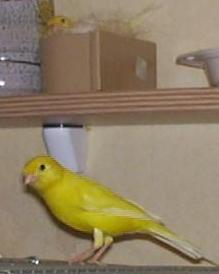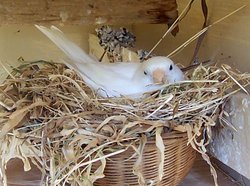Canary
|
|
| Canary | ||||||||||||||
|---|---|---|---|---|---|---|---|---|---|---|---|---|---|---|
| Missing image Canary.jpg Yellow canary Domesticated Canary | ||||||||||||||
| Scientific classification | ||||||||||||||
| ||||||||||||||
| Binomial name | ||||||||||||||
| Serinus canaria (Linnaeus, 1758) |
The Canary (Serinus canaria) is a small songbird which is a member of the finch family.
This bird is native to Madeira and the Canary Islands; it was named for the latter, although the name of the island group comes from the Latin word for dog, "cannariae," given by the Romans in reference to the numerous wild dogs that lived there.
Its habitat is semi-open areas such as orchards and copses, where it nests in bushes or trees.
The wild bird is yellow-green, with streaking on its back. At 13cm length, it is larger, longer and less contrasted than its relative the Serin, and has more grey and brown in its plumage.
The song is a silvery twittering like the Goldfinch.
Canaries were first bred in the 1600's. They were brought over by Spanish sailors to Europe. Monks started breeding them and only sold the males (which sing). This kept the birds in short supply and drove the price up. Eventually Italians obtained hens and were able to breed the birds themselves. This made them very popular and resulted in many breeds arising and the birds being bred all over Europe.
The same occurred in England. First the birds were only owned by the rich but eventually the local citizens started to breed them and, again, they became very popular. Many breeds arose through selective breeding.
Canaries are generally divided into three main groups: Colorbred Canaries (bred for their many color mutations - Ino, Eumo, Satinette, Bronze, Ivory, Onyx, Mosaic, Brown, etc.), Type Canaries (bred for their shape and conformation - Border, Gloster, Gibber Italicus, Raza Espanola, Berner, Lancashire, Yorkshire, etc.), and Song Canaries (bred for their unique and specific song patterns - Spanish Timbrado, Roller, Waterslager (also known as "Malinois"), American Singer, Russian Singer, Persian Singer).
Canaries are judged in competitions every fall. Shows generally begin in October and November after the breeding season ends. Birds can only be shown by the person who raised them. They all have unique bands on their legs that indicate the year of birth, the unique band number, the club to which the breeder belongs. Song Canaries are judged later in the year (January).
There are many canary bird shows all over the world. The world show (C.O.M.) is held in Europe each year and attracts thousands of breeders. As many as 20,000 birds are brought for competiton.
The keeping of Canaries for their appearance and song is a tradition that dates back centuries.
Canaries were once regularly used in coal mining as an early warning system. Toxic gases such as carbon monoxide and methane in the mine would kill the bird before affecting the miners. Because canaries tend to sing much of the time, they provided both a visual and audible cue in this respect. The use of canaries in British mines was phased out as recently as 1986.
Canaries are often depicted in cartoons from the middle 20th century as being harassed by domestic cats; the most famous cartoon canary is Warner Brothers' "Tweety Bird".
In computing, canaries or canary words are dummy data fields used in the implemention of stack-smashing protection. The name is an allusion to the use of canaries as warning devices in coal-mines.
Photos
|
| 
|

